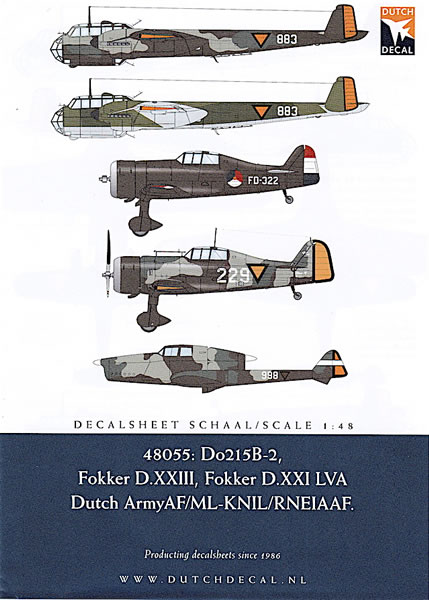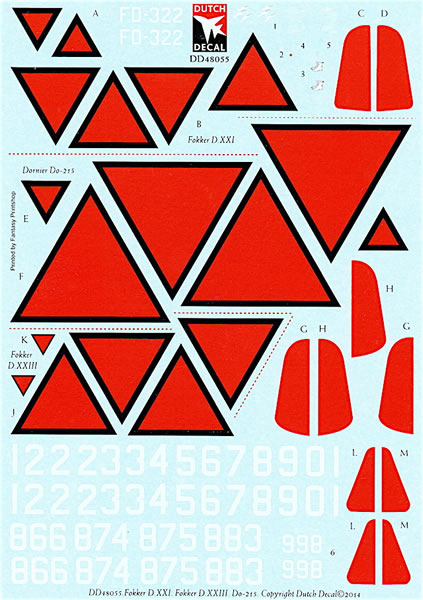Do 215 B-2, Fokker D.XXIII, Fokker D.XXI LVA

Dutch Decal, 1/48 scale
| S u m m a r y : |
Catalogue Number and Description |
Dutch Decal Item No. DD48055: Do 215 B-2, Fokker D.XXIII, Fokker D.XXI LVA: Dutch Army AF/ML-KNIL/RNEIAAF |
Scale |
1/48 scale |
Contents and Media |
1 sheet of waterslide decals with markings for 8 aircraft – 4 Do 215s, 1 D.XXIII, and 5 D.XXIs; 1 x fold-out A3 double sided full colour instruction leaflet |
Price |
Not currently listed on the Dutch Decal website, but available online from Aviation Megastore for €14.95.
The website also includes a list of online and hobby shop stockists |
Review Type |
First Look |
Advantages |
Interesting subjects; high quality decals; excellent instructions. |
Disadvantages |
Pre-1939 roundels for three of the D.XXI options are not included in this package. |
Conclusion |
This is a comprehensive and – because of its ‘what-if’ Do 215 subjects – slightly offbeat release. Essential for anyone interested in modelling World War II Dutch aircraft, both real and potential. |
Reviewed by Brad Fallen

Iliad Decals' 1/48 scale ANG Mustangs is available online from Squadron.com
This 1/48 scale release from Dutch Decal is an interesting mix of real and almost-was. Of the three aircraft types featured only one, the Fokker D.XXI, entered Dutch service; the Fokker D.XIII likely would have done so, but only one example was completed before Germany invaded in May 1940.
The same invasion nullified the Netherland's intended purchase of 24 Dornier Do 215 B-2s. However, Dutch Decal has taken a 'what if' approach and provided decals, and suggested schemes, as if the Dorniers had been delivered.
Markings are provided for four Do 215s – 866, 874, 875 and 883 – with two camouflage options suggested. The first is an ‘off-the-shelf’ Luftwaffe scheme of RLM 70 Dark Green and RLM 71 Black Green splinter over RLM 65 Light Blue, which the instructions claim was adopted to “reduce cost and time”. The second is the pre-war Netherlands scheme of grey, brown and green. In both variations the aircraft carry orange and black national markings in six positions, with the same colours repeated on the rudders.
All of the remaining decal options actually existed – although in the D.XXIII’s case not for very long, with the instructions pointing out that the sole prototype was “probably destroyed during the German invasion in May 1940”. This and all of the D.XXIs (bar one) were also camouflaged in grey, brown and green. Two black-and-white photos of the prototype are included in the instructions, although the ‘X-4’ codes on the tail booms in the photos don’t match the ‘998’ serials in the same location in the colour profiles.

The five D.XXIs featured have been selected to show the evolution of camouflage applied to the type:
- The first, ‘FD-322’, is a pre-production aircraft built for the ML-KNIL (Royal Netherlands East Indies Army), painted in overall brown and wearing pre-1939 red, white and blue roundels with a central orange dot. The instructions note that the rudder on this prototype was slightly smaller than that of production D.XXIs, a modification that will require some careful shaping of your kit rudder.
- The next two machines, ‘213’ and ‘227’, also have tri-colour roundels but are finished in grey, brown and green camouflage. ‘213’ also has a red, white and blue rudder, making it a very colourful aircraft, but ‘227’ is in post-Munich Crisis guise with a brown painted rudder and newly fitted radio mast.
- The final two D.XXIs, ‘223’ and ‘235’, are in the type’s 10 May 1940 configuration with black and orange triangles in six positions and also black-bordered orange rudders.
The decals are by Fantasy Printshop and supplied on a single sheet. Quality is high with good colour density and crisp demarcation between the orange and black on the triangles. It’s important to note these are the only national markings supplied – I couldn’t find the red, white and blue roundels for the pre-1939 D.XXIs and at first thought they were missing, before spotting advice in the instructions that the roundels are available on a separate Dutch Decal sheet.
Other points to be aware of are:
- the serial numbers for the final four D.XXIs above are printed in a continuous strip in numerical order – ie ‘12223345678901’. This means that unless you are building aircraft ‘223’ you will need to do some cutting, mixing and matching of numbers to achieve the serial you need.
- The orange rudder markings will need to be applied to a pre-painted black rudder to achieve the necessary black border.
The instructions are excellent and presented on Dutch Decal’s usual fold out A3 sheet. All marking illustrations are in full colour, with overhead plans and port and/or starboard profiles for each type. There are also several scrap drawings showing some specific variations and markings.
The illustrations are accompanied by informative captions that include details of the history and (where known) fate of each aircraft. Decal locations are clearly marked and US Federal Standard numbers are used to call out paint colours.
Finally, specific 1/48 kits are recommended for each aircraft type – ICM for the Do 215, Classic Airframes/Special Hobby for the D.XXI, and RS Models for the D.XXIII.
This is a comprehensive and – because of its ‘what-if’ Do 215 subjects – slightly offbeat Dutch Decal release. However it’s also popular (the set is no longer available on the company website, and hard to find elsewhere on the internet), and deservedly so. The aircraft featured are all interesting; I’ve always intended to complete my Classic Airframes D.XXI as a Finnish defender, but the May 1940 examples on this sheet are very tempting! Essential for anyone interested in World War II Dutch aircraft, both real and potential.
Highly recommended
Thanks to Dutch Decals for the review sample.
Text and Images Copyright © 2016 by Brad Fallen
This Page Created on 20 September, 2016
Last updated
20 September, 2016
Back to
HyperScale Main Page

|
